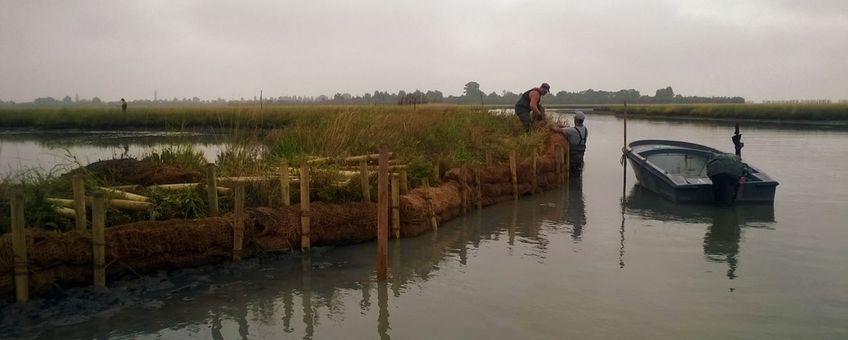
Bioengineering, stakeholder participation and ecosystem services valuation protect salt marshes in the lagoon of Venice
Foundation for Sustainable DevelopmentThe lagoon around Venice in north-eastern Italy is the largest wetland along the coasts of the Mediterranean Sea. It is one of the most important lagoons in Europe due to its large surface (about 550 square kilometre), valuable habitats and long history of human civilization. The salt marshes, locally known as “barene”, are a key tidal landform of the Venice lagoon. They resemble low-lying islands which are regularly submerged during tidal cycles. The salt marshes are covered by specialized grasses and shrubs adapted to the extreme environmental conditions such as high soil salinity in combination with temperature and water level oscillations. The salt marsh' unique habitats are home to rare species of plants and birds, and are therefore safeguarded by the Birds and Habitats EU Directives as part of the “Natura 2000” EU-wide ecological network of protected areas.
Large-scale erosion in the Venice lagoon
More than 70% of the salt marshes of the Venice lagoon was lost over the past century because of widespread and intense erosion mainly due to human actions. This primarily entails speeding motor boats causing high energy waves; the excavation of deep channels and modifications made to the lagoon inlets allowing the transit of large cargo and cruise ships which changed the lagoon hydrodynamics and sediment budget; and invasive clam fishing. To protect salt marshes from erosion, the European Commission has funded the demonstrative project LIFE VIMINE, as a part of the LIFE Programme supporting the Natura 2000 network. The LIFE VIMINE project aims to protect the most interior salt marshes of the northern Venice lagoon. They are hard to access using the classical means to contrast erosion: the commonly used large boats and heavy mechanical means would damage these delicate habitats during the construction phase of protections. Therefore, LIFE VIMINE shows the effectiveness of a novel, integrated approach to salt marsh conservation.
Bioengineering
LIFE VIMINE uses barriers of biodegradable fascines made of branches to protect the marsh edges, resulting in the construction of small but spatially-diffuse and environmentally-friendly soil bioengineering works to prevent erosion. During the construction phase, great care is paid to minimize the impact on the landscape and the environment, for example because the barriers are mainly built through semi-manual labor. The durability and efficacy of these protection works are ensured in the long term through routine actions of monitoring and maintenance of the salt marsh landscape. This allows prompt action to repair damaged protection works or defend new eroding salt marsh edges, preventing erosion while minimizing costs.
Social economic activities
In LIFE VIMINE, erosion is not just set off physically through soil-bioengineering works, the project also stimulates the demand for changing attitudes and life-styles related to erosion. Because human causes of erosion are linked to socio-economic drivers, conservation actions must address erosion also on the socio-economic level to be sustainable. LIFE VIMINE promotes the involvement of local communities and stakeholders through outreach activities towards schools and ship owners, and the participation of stakeholders. The best locations to install protection works are discussed with lagoon citizens who are later asked to report new marsh erosion spots needing protection. Local workers such as fishermen are employed to place protection works, since they know how to efficiently navigate through the mazy and shallow lagoon and are motivated to protect their own territory. A network of sustainable lagoon businesses (e.g. ecotourism) is created to promote a sustainable local economy and, at the same time, reduce the environmental impacts of those businesses. The overall goal of those participation activities is raising public awareness of the fact that protecting salt marshes means defending the benefits, both social (jobs), economic and environmental, that they provide to society through their presence and ecological functions. The creation of local jobs linked to conservation also helps to make conservation sustainable. This is particularly important in a time of economic crisis when the small lagoon islands where fishermen live suffer higher depopulation.

Ecosystem services valuation
LIFE VIMINE shows the local society that the benefits of salt marsh protection outweigh its costs. A key project action is the socio-economic assessment of conservation. The value of the jobs linked to the existence or conservation of salt marshes and the value of the various ecosystem services that salt marshes provide (carbon sequestration, nutrient abatement, support to commercial fish species, shore protection, etcetera) are quantified in monetary terms and then communicated to the institutions managing the lagoon. In this way, ecosystem services valuation, recently promoted by European policies such as the EU Biodiversity Strategy to 2020, is used as an operational decision support tool in the framework of a cost-benefit analysis, to promote investments in nature conservation in the lagoon.
Text: Laura Grechi and Alberto Barausse, University of Padova; Sara Mulder, Foundation for Sustainable Development
Photos: LIFE VIMINE staff (leadphoto: local fishermen hired in the project place fascines to protect salt marsh edges from erosion); Vittorio Busatto
Map: Google Maps

